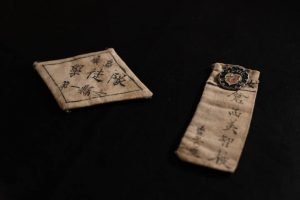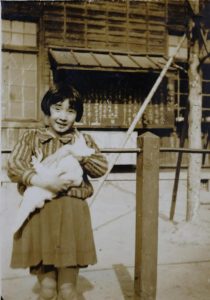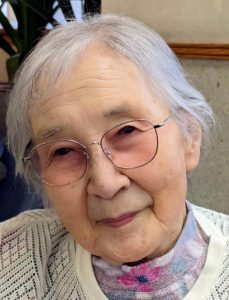Hatsue Shigeyama passes on memories of younger sister to daughter through belongings
Aug. 2, 2024
Walking in search of sister the day after the A-bombing, Shigeyama in Fukuyama City finds name tag and student corps badge in burnt ruins
by Minami Yamashita, Staff Writer
“She was cheerful, responsible, and just so cute,” said Hatsue Shigeyama, 99, an atomic bomb survivor living in Fukuyama City. The day after the atomic bombing, she walked through the central area of Hiroshima City, which was burned to the ground, searching for her younger sister, Michie Kuranishi, then 13, a first-year student at Hiroshima Prefectural First Girls’ High School (Prefectural Girls’ School; now Minami High School). All she could find were a few items, including the name tag she was wearing. As the 79th anniversary of the A-bombing approaches, Ms. Shigeyama has entrusted her daughter with the terrible memories she had kept hidden in Michie’s belongings.
The name tag reads, “Hiroshima Prefectural First Girls’ High School, Michie Kuranishi, Blood type O,” with the school’s heart-shaped emblem attached. Other items found include a school corps badge and an identification card. They had been kept in a Buddhist altar at the former home in Nishi Ward of Hatsue’s other younger sister, Chizue Kato, who passed away in 2006 at the age of 78. “I brought them home,” said Hatsue, revealing for the first time to her eldest daughter, Yoko Hasegawa, 67, a resident of Fukuyama, the devastation that occurred 79 years ago.
Mobilized to engage in the work of creating fire lanes
Hatsue and her family lived in Kojin-machi (now part of Minami Ward). On August 6, 1945, first-year students at Prefectural Girls’ School were mobilized to engage in the work of creating fire lanes in the Dobashi area (now part of Naka Ward), about 800 meters from the hypocenter. Michie unusually hesitated to go, but her mother sent her off, saying, “You’re the class president, aren’t you?” She stepped out of the entrance, waving her hand. That was the last time she saw her family.
The United States Military dropped an atomic bomb on the central area of Hiroshima City. Hatsue was exposed to the A-bombing at home with her mother. Leaving her mother to take care of her father, who had suffered severe burns nearby, Hatsue set out early on the morning of August 7 to search for her missing younger sister.
She found a torn piece of her younger sister’s favorite polka-dotted blouse behind a building near Dobashi-cho. She learned the first-year students at Prefectural Girls’ High School had been taken to Koi National School (present-day Koi Elementary School in Nishi Ward), and when she got there, she was confronted with numerous deaths.
“Their whole bodies were black like burnt fish, their hair was burned, their bodies were blistered, and they looked anything but humans,” she said. Searching for clues about her younger sister, she “rummaged through the bodies with her bare hands, hoping to find even a small piece of charred clothing, but found nothing.” Chizue recorded what she heard from Hatsue in her memoir.
Michie had already been cremated with other bodies. Hatsue had no choice but to take home the nametag and other belongings that were laid out on the schoolyard. She said a teacher from the Prefectural Girls’ School who was present told her that when he called out to see whether any Prefectural Girls’ School students were there, Michie, who had been severely burned, sat upright with her classmates and raised her hand. On August 8, her father left this world for his youngest daughter, saying, “I’m going now so she won’t be lonely.”
Troubled by nightmares
After Hatsue burst into talking to Yoko about her experience of the A-bombing early this year, she was troubled by nightmares. Yoko said, “My soft-natured mother searched around the hypocenter area by herself. She must have been living with a deep wound in her heart for a long time.”
Several photos of Michie were also found in the Buddhist altar. One of the photos was a postwar composite photo of Hatsue in her school uniform as a Prefectural Girls’ School graduate superimposed on a smiling face of Michie’s childhood. Yoko said, “My mother probably wanted to leave evidence that Michie had attended Prefectural Girls’ School.” August 6 comes around again. Feeling an even deeper connection to the girl whose future was cut short by the A-bombing, Yoko joins her hands in prayer.
(Originally published on August 2, 2024)










